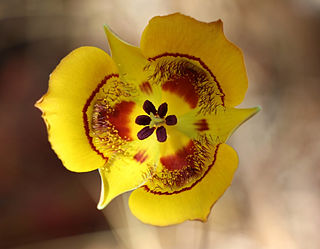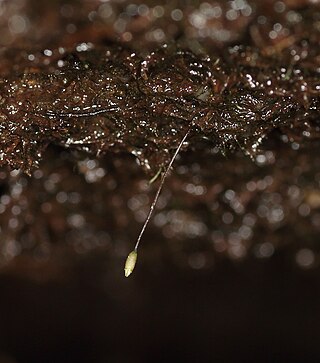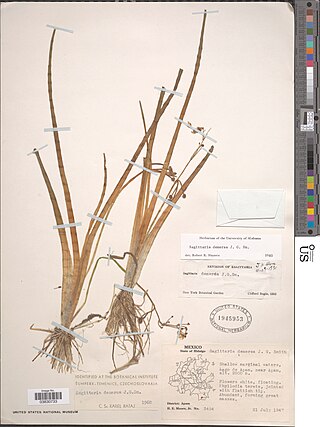
Triadenum, known as marsh St. John's worts, is a small genus of flowering plants in the family Hypericaceae. The genus is characterized by opposite, blunt-tipped leaves and pink flowers with 9 stamens. They are distributed in North America and eastern Asia.

Physocarpus, commonly called ninebark, is a genus of flowering plants in the family Rosaceae, native to North America and northeastern Asia.

Pharus, the stalkgrasses, is a genus of Neotropical plants in the grass family.

Calochortus clavatus is a species of mariposa lily known by the common name clubhair mariposa lily. It is endemic to California where it is found in forests and on chaparral slopes.

Tetrodontium brownianum is a species of moss commonly known as Brown's tetrodontium moss or Brown's four-tooth moss. It is widely distributed. In North America it is found in Washington state and British Columbia on the west coast and from Newfoundland to Ohio to the east. It is also present in Austria, France, Germany, Ireland, Norway, Sweden, Switzerland and the United Kingdom as well as Japan, New Zealand and Chile.

Spiranthes ochroleuca, commonly called the yellow nodding lady's tresses, is a species of orchid occurring from southeastern Canada to the eastern United States.

Trisetum is a genus of plants in the grass family, widespread in temperate, subarctic, and alpine habitats in much of the world. Oatgrass is a common name for plants in this genus.

Selaginella uncinata, the blue spikemoss, peacock moss, peacock spikemoss, or spring blue spikemoss, is a species of plant in the Selaginellaceae family.
Najas filifolia, the needleleaf waternymph, is an aquatic plant in the Hydrocharitaceae. It is a rare and little-known species, known from only three counties (Decatur County, Georgia; Santa Rosa County, Florida; and Leon County, Florida. It is unusual in the genus in bearing fruits that are recurved to crescent-shaped.
Phyllospadix serrulatus is a species of aquatic plant in the Zosteraceae family. It is referred to by the common name toothed surfgrass, and is found along the shorelines of British Columbia and southern Alaska. It is also found in Oregon. It grows in salt marshes in the intertidal zone.

Najas gracillima, the slender waternymph, is a submerged species of aquatic plant in the Hydrocharitaceae family. found in lakes and streams. It is native to China, Russian Far East, Japan, Korea, Taiwan, Iran, Alberta, Ontario, Newfoundland, Nova Scotia, New Brunswick, the eastern United States. It is also considered introduced and naturalized in France, Spain, Italy and California.

Sagittaria trifolia, the threeleaf arrowhead or Chinese arrowhead, is a plant species widespread across the wet areas in Europe and in much of Asia.

Sagittaria papillosa, the nipplebract arrowhead, is a perennial plant species growing up to 120 centimetres tall. Petioles are triangular in cross-section, the leaf blade very narrowly elliptical to ovate, not lobed. The species is distinguished from others in the genus by having bumps (papillae) resembling nipples on the flower bracts.

Sagittaria rigida, the sessilefruit arrowhead or Canadian arrowhead, is an aquatic plant species. It has narrow oval leaves rather than the iconic arrowhead shaped leaves of species like the Sagittaria latifolia. it has sessile female flowers, from whence its name comes. Its flowers are very similar to other plants in the Sagittaria family, with three white petals.

Sagittaria cristata, the crested arrowhead, is a perennial herb growing up to 75 centimetres tall. The leaves are flat, long and narrow, not lobed, and up to 40 cm (16 in) long. The flowers are white.

Sagittaria demersa, commonly called Chihuahuan arrowhead, is an annual aquatic plant growing up to 60 centimetres tall. The leaves are flat, very long and narrow, up to 55 cm (22 in) long but rarely more than 7 millimetres across.

Sagittaria guayanensis, the Guyanese arrowhead, is a perennial aquatic plant species native to both the Old and New World. It has broadly hastate (arrow-shaped) leaves with ovate lobes.

Bradburia pilosa, the soft goldenaster, is a North American species of flowering plants in the family Asteraceae, native to the south-central United States, primarily the southeastern Great Plains and lower Mississippi Valley, in the states of Texas, Oklahoma, Kansas, Missouri, Arkansas, Louisiana, Tennessee, Mississippi, and Alabama. Additional populations are reported farther east but these appear to be introductions. Its habitats include disturbed roadsides and pine-oak-juniper woods.

Carex rariflora, the looseflower alpine sedge, is a species of plant in the sedge family. It is found in the United States in Alaska and Maine, and in Canada in New Brunswick and Nova Scotia. In these regions, it is ranked as an obligate hydrophyte in establishing wetland areas. It prefers wet environments such as open bogs, meadows, seepage slopes, and low-elevation heath tundra. This perennial grass, which can be up to 3 feet tall, has fibrous roots, and holds all perennial organs underground. The leaves are alternate, long, narrow, and simple, with parallel veins. They grow in dense clusters, and the dead leaves are found at the base of the plant. The plant blooms and fruits in the summer. All flowers are monoecious and unisexual, producing a spike inflorescence. All inflorescences are subtended by shorter, proximal bracts.

Isoetes butleri, commonly known as limestone quillwort, is a species of plant in the quillwort family, a member of the lycophytes.


















